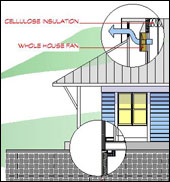""Large corporations appear as the visible leaders in the green building movement; but it is organizations like the Common Fire Foundation whose commitment, dedication, and grassroots work will be a driving force to accelerate change. Projects like the Common Fire Housing Co-op will help shape the future of green building practices and sustainable lifestyles... throughout the nation and the world."
 -- Tracie Hall, Executive Director,
-- Tracie Hall, Executive Director,
 USGreen Building Council,
USGreen Building Council,
 New York Upstate Chapter
New York Upstate Chapter
People's choices about the buildings they live and work in have the greatest impact on the environment of any single decision they make as individuals, rivaled only by their choice and use of cars. In the United States buildings account for:
- 36% of total energy use and 65% of electricity consumption
- 30% of greenhouse gas emissions
- 30% of raw materials use
- 30% of waste output
- 12% of potable water consumption
Meanwhile the Environmental Protection Agency classifies indoor air quality as one of the top five environmental health risks today.

|
|
Click for complete drawing of building
|
Studies show - and our experience corroborates - that even really green buildings need not cost much more than standard custom-built buildings. There are many things people can do that will save energy and materials that actually SAVE money right off the bat, and there are a whole range of things that do cost more up front but save a lot of money over time, especially as energy costs begin to really rise in coming years.
(For a breakdown of which strategies cost less up front and which save money over time, you can download our free brochures. Note: They are large files. They take a minute each on high-speed internet. 15 Ways to Green Your Existing Home or Building, or 17 Ways to Green A New Building)

The USGBC has developed standards for green buildings, and is working on standards for green neighborhoods.
Check them out here...
|
|
The concept of green building is not new but there exists today a standardized rating system through the US Green Building Council that provides a framework for assessing building performance and general sustainability. Numerous states, cities and other non-profits have developed their own frameworks, though most do not have a mechanism for actually verifying whether a building met their standards or not. While some appear to be otherwise solid, many are pretty watered down, most notably the "Green Globes" standards which are really weak when it comes to things like sustainable harvesting of wood and the impact of products on human health.

Providing technical advice, consultation and incentives NYSERDA is a major resource for any green building project in New York State.
|
|
In the USGBC system, buildings are scored according to how many criteria they meet in six categories, with 26 points earning certification. Buildings that go beyond that can earn a silver, gold, or platinum certification.
Enthusiasm is so great for green building and this rating system that California and Arizona have mandated that all new public buildings be designed and built to earn silver certifications. The town of Scottsdale, Arizona passed a resolution in March that all of its new public buildings must earn gold certifications. Builders as far away as India are regularly using the rating system to certify their buildings.

The Common Fire building was designed by Chuck Silver of Hudson River Design.
|
|
In the fall of 2006 the Common Fire Foundation completed construction of a housing co-op in Tivoli, NY, just two hours north of New York City in the Hudson River Valley. The Common Fire Housing Co-op is a landmark for the region and the country, certified as the highest scoring green building in the Eastern United States" with 57 points, 4 more than the next greenest building in the East. (Click here to see an Excel spreadsheet listing the points we scored.)
All of this is was achieved in the context of a building that is beautiful,
comfortable, and convenient. We offer regular tours -- please call or e-mail to schedule a visit.
Continue the tour: Energy and Atmosphere

